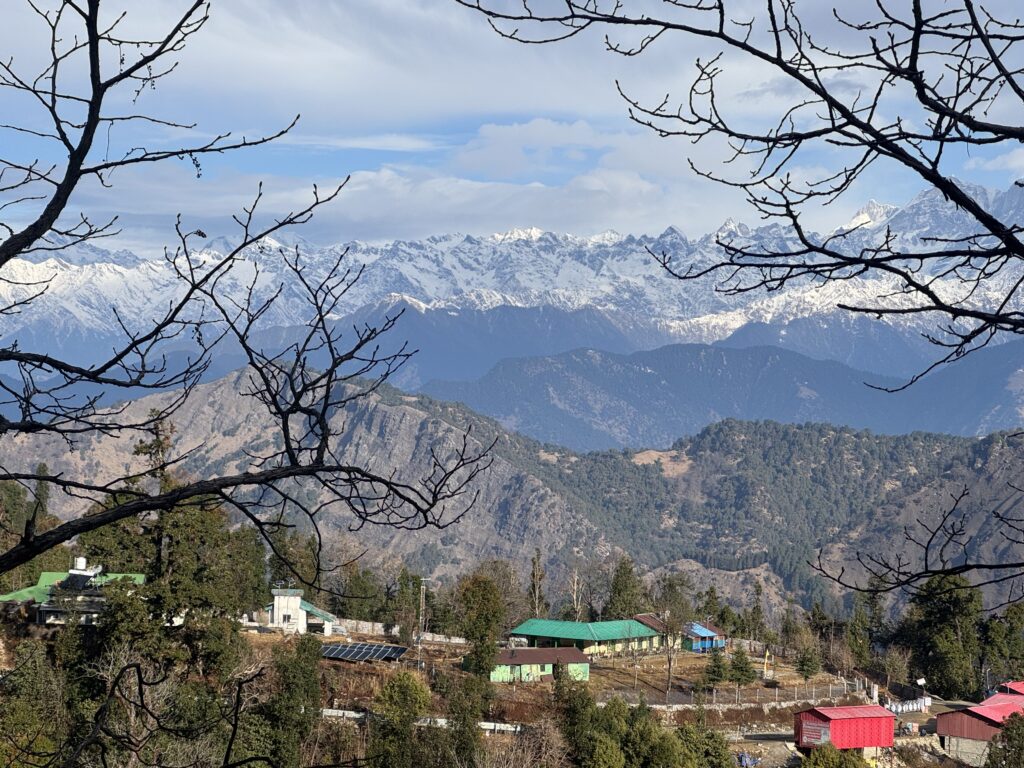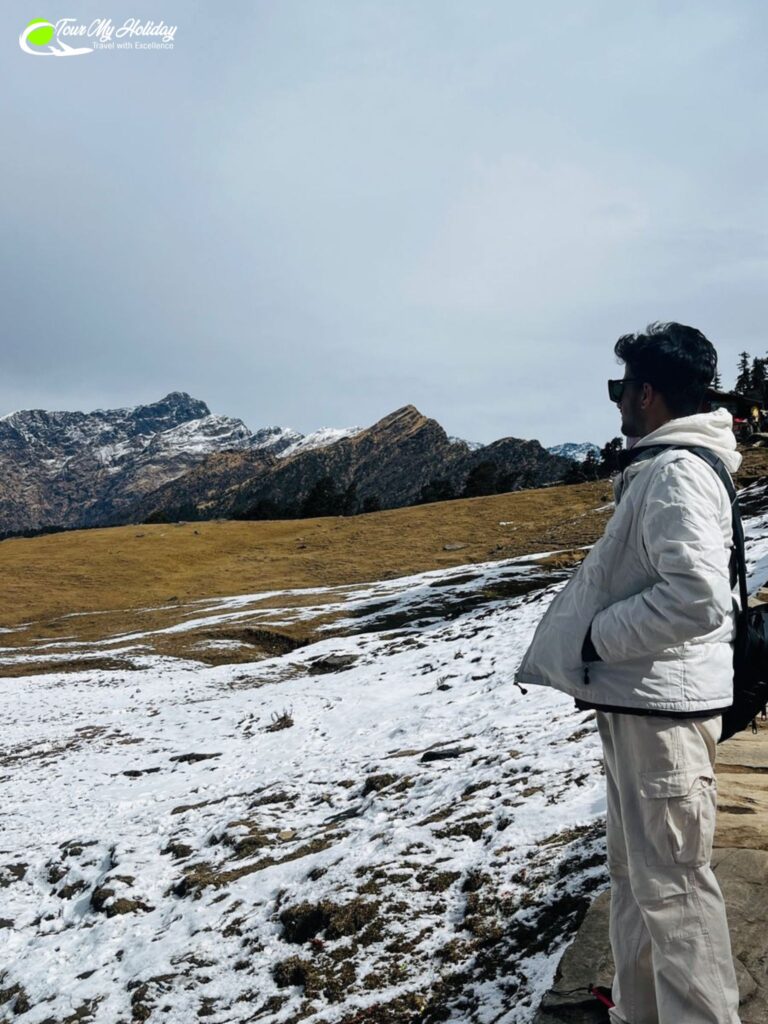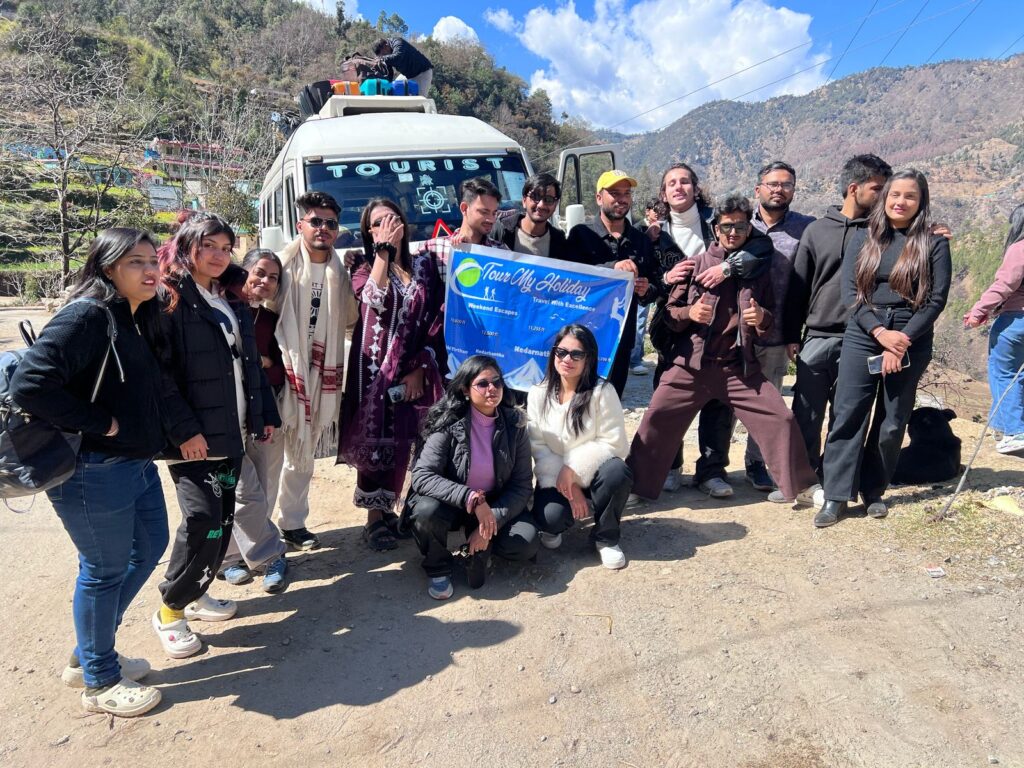Introduction to Chopta
Nestled in the heart of Uttarakhand, Chopta is a pristine and breathtaking destination that remains untouched by excessive tourism. Often referred to as the “Gateway to Tungnath,” this scenic hill station is surrounded by dense forests of rhododendrons, deodar, and pine, offering a perfect escape into nature. With its panoramic views of the Himalayan peaks, including Nanda Devi, Trishul, and Chaukhamba, Chopta tour package attract nature lovers, adventure seekers, and spiritual travelers alike.
One of the biggest highlights of a Chopta tour package is the Tungnath Temple Trek, which leads to the highest Shiva temple in the world. Trekking enthusiasts also embark on the Chandrashila Trek, which rewards them with a mesmerizing 360-degree view of the Himalayas. Whether you’re looking for a Chopta Tungnath Trek from Delhi or a Chopta Chandrashila Trek from Delhi, the journey to this Himalayan paradise is nothing short of magical.
Apart from trekking, Chopta offers opportunities for camping under the stars, birdwatching, and exploring the Himalayan biodiversity. Whether visiting in summer for lush greenery or winter for snow-covered landscapes, Chopta tour packages cater to travelers all year round. A trip to Chopta is an unforgettable experience for those who seek adventure, peace, and natural beauty.

Chopta Tungnath Trek: A Journey to the Highest Shiva Temple
The Chopta Tungnath Trek is a perfect blend of spirituality, adventure, and breathtaking natural beauty. Nestled in the Garhwal Himalayas, Chopta serves as the base for the Tungnath Temple Trek, which leads to the world’s highest Shiva temple, Tungnath, sitting at an altitude of 3,680 meters. The trek further extends to Chandrashila Summit Trek, offering panoramic views of the majestic Himalayan peaks.
For travelers seeking both devotion and adventure, the Chopta Tungnath Trek from Delhi is an ideal getaway. Whether you choose a Chopta Chandrashila Trek from Delhi or opt for a Tungnath Chandrashila Trek from Delhi, this journey promises an unforgettable experience. Through this blog, we will explore everything you need to know about the Chopta Tungnath Trek, including its significance, difficulty level, itinerary, best time to visit, and essential travel tips.
Reason For Choosing the Chopta Tungnath Trek!
The Chopta Tungnath Trek is one of the most scenic and rewarding treks in Uttarakhand. It stands out for several reasons:
- Spiritual Significance – The Tungnath Temple Trek takes you to the highest Shiva temple in the world, which is believed to be over 1,000 years old and is part of the sacred Panch Kedar.
- Breathtaking Views – The Chandrashila Summit Trek offers mesmerizing 360-degree views of Nanda Devi, Chaukhamba, Kedarnath, and Trishul peaks.
- Accessibility – Compared to other high-altitude treks, the Chopta Tungnath Trek from Delhi is easily accessible and does not require extensive trekking experience.
- All-Season Trek – Whether covered in lush greenery during summer or draped in snow during winter, the Chopta Tungnath Trek remains a year-round attraction.
- Diverse Flora and Fauna – Chopta, part of Kedarnath Wildlife Sanctuary, is home to vibrant rhododendron forests, musk deer, monals (the state bird of Uttarakhand), and other Himalayan species.

Difficulty Level of the Chopta Tungnath Trek
The Chopta Tungnath Trek is considered easy to moderate, making it ideal for beginners and experienced trekkers alike.
- Chopta to Tungnath Temple – A well-marked 3.5 km trek with gradual ascents.
- Tungnath to Chandrashila Summit – A steep 1.5 km climb that requires good stamina.
- Winter Trekking – The Chopta Chandrashila Trek in winter can be challenging due to snow-covered trails, requiring proper gear and precautions.
Essential Packing List for Chopta Tungnath Trek
✔ Warm clothes (even in summer, nights can be cold)
✔ Trekking shoes with good grip
✔ Raincoat or poncho (for monsoon treks)
✔ Trekking pole for support
✔ Torch with extra batteries
✔ First-aid kit and personal medications
✔ Dry fruits, energy bars, and water bottle
✔ Camera and binoculars for photography and birdwatching

Safety Tips for Chopta Tungnath Trek
Stay hydrated and carry enough food supplies.
Acclimatize properly before starting the trek to avoid altitude sickness.
Start early in the morning to complete the trek before sunset.
Wear proper trekking gear, especially in winter, when snow can make the trails slippery.
Follow eco-friendly practices – do not litter or disturb the wildlife.
Chandrashila Trek: Witness the Beauty from the Summit
The Chandrashila Summit Trek is one of the most rewarding treks in the Indian Himalayas, offering a mesmerizing blend of adventure, spirituality, and breathtaking natural beauty. Standing at an altitude of approximately 4,000 meters, the Chandrashila Summit provides an awe-inspiring 360-degree view of the Garhwal Himalayan range, including Nanda Devi, Trishul, Kedarnath, and Chaukhamba peaks.
This trek is often combined with the Chopta Tungnath Trek, as the route passes through Tungnath Temple, the highest Shiva temple in the world. Whether you’re embarking on a Tungnath Chandrashila Trek from Delhi or choosing a well-curated Chopta tour package, this journey is a dream for trekkers, photographers, and nature lovers.
In this comprehensive guide, we will explore everything about the Chandrashila Trek, including its significance, trekking route, difficulty level, best time to visit, and essential travel tips.

Why Choose the Chandrashila Summit Trek?
The Chopta Chandrashila Trek is an ideal trek for both beginners and experienced trekkers. Here’s why it stands out:
1. Mesmerizing Himalayan Views
The Chandrashila Summit Trek rewards trekkers with unparalleled views of the Himalayan giants, including Nanda Devi, Kedarnath, Chaukhamba, and Trishul peaks. The breathtaking sunrise from Chandrashila is one of the most mesmerizing sights you will ever witness.
2. Sacred Tungnath Temple Trek
The Tungnath Temple Trek is an integral part of this journey. As the highest Shiva temple in the world, Tungnath holds immense religious significance. Trekkers often pause here to seek blessings before continuing towards Chandrashila Summit.
3. Accessible All Year Round
Unlike many high-altitude treks that are inaccessible during winter, the Chopta Chandrashila Trek from Delhi is open throughout the year. Whether you choose to visit in summer for lush greenery or in winter for snow-covered landscapes, every season offers a unique experience.
4. Diverse Flora and Fauna
The trek takes you through the Kedarnath Wildlife Sanctuary, home to diverse wildlife, including the Himalayan monal (Uttarakhand’s state bird), musk deer, and foxes. The vibrant rhododendron forests make spring the most colorful season to visit.

Difficulty Level of the Chandrashila Summit Trek
The Chopta Chandrashila Trek is classified as an easy to moderate trek, making it suitable for beginners. However, it does include some steep sections:
- Chopta to Tungnath Temple Trek – A well-paved 3.5 km trail with a gradual ascent.
- Tungnath to Chandrashila Summit Trek – A steep 1.5 km climb requiring endurance and stamina.
- Winter Trekking – The Chopta Tungnath Trek from Delhi during winter is more challenging due to snow-covered trails and freezing temperatures.
Ideal Time to Visit Chandrashila Summit Trek
Each season offers a unique experience for trekkers:
- Spring (March to May) – The trail is surrounded by vibrant rhododendron flowers, creating a stunning contrast against the backdrop of the Himalayas.
- Monsoon (June to September) – The landscape turns lush green, but the trek can be slippery due to heavy rainfall.
- Autumn (October to November) – One of the best seasons with crisp, clear skies and pleasant weather.
- Winter (December to February) – Ideal for a Chopta Winter Trek, as the trail is covered in thick layers of snow, offering a magical winter wonderland.
Packing List for the Chandrashila Summit Trek
✔ Warm clothes, including thermals, fleece jackets, and windproof layers
✔ Waterproof trekking shoes with good grip
✔ Trekking pole for support
✔ First-aid kit and personal medications
✔ Snacks, energy bars, and dry fruits
✔ Sunglasses, sunscreen, and lip balm for sun protection
✔ Power bank and camera for capturing the Himalayan beauty

Must-Visit Attractions in Chopta
Deoriatal – A Reflection of the Himalayas
Located 3 km from Sari Village, Deoriatal is a high-altitude lake known for its crystal-clear waters and breathtaking reflections of Chaukhamba Peak.
Why Visit Deoriatal?
- Mirror-Like Reflection of the Himalayas
- Rich Biodiversity – Spot Himalayan birds, deer, and foxes
- Perfect Camping & Stargazing Spot
Many Chopta tour packages include an overnight camping experience near Deoriatal Lake.
Rohini Bugyal – A Hidden Meadow in Chopta
Rohini Bugyal is a lesser-known but incredibly beautiful alpine meadow located along the Chopta Tungnath Trek route. It is perfect for travelers looking for serenity and nature walks.
Why Visit Rohini Bugyal?
- Scenic Landscapes – Rolling meadows covered in rhododendron flowers.
- Peaceful and Less Crowded – Ideal for meditation, relaxation, or photography.
- Wildlife Sightings – Spot Himalayan Monal, musk deer, and wild foxes.
Ukhimath – The Winter Seat of Kedarnath
Ukhimath, a small town near Chopta, is famous for its temples and spiritual aura. It serves as the winter home for the Kedarnath deity.
Why Visit Ukhimath?
- Rich Mythological Significance – Visit the Omkareshwar Temple, where the idol of Lord Kedarnath is worshipped during winter.
- Gateway to Chopta – Ukhimath is a major stop for those heading towards Chopta Tungnath Trek from Delhi.
- Scenic Beauty – Stunning views of Himalayan peaks and terraced fields.

Kanchula Korak Musk Deer Sanctuary
For wildlife enthusiasts, the Kanchula Korak Musk Deer Sanctuary is a must-visit attraction in Chopta. Spread over 5 sq km, it is home to the endangered Himalayan Musk Deer.
Why Visit Kanchula Korak Sanctuary?
- Rare Wildlife – Spot musk deer, leopards, barking deer, and Himalayan Monals.
- Dense Forest Trails – Perfect for nature walks and birdwatching.
- Photographer’s Paradise – Ideal for wildlife and landscape photography.
If you are on a Chopta tour package, consider a stop at this hidden gem.
Bisurital – An Untouched Trekking Destination
Bisurital is a pristine high-altitude lake situated at 4,000 meters and is a relatively offbeat trekking destination near Chopta.
Why Visit Bisurital?
- Unspoiled and Remote – Experience raw nature without tourist crowds.
- Adventure Trekking – A challenging but rewarding trek of about 30 km from Chopta.
- Panoramic Himalayan Views – Similar to Chandrashila Summit but far more secluded.
Adventure Activities in Chopta
- Trekking on various trails like Chopta Tungnath Trek and Chopta Chandrashila Trek.
- Camping under the stars with Chopta Camping Packages.
- Bird watching, as Chopta is home to many rare Himalayan species.
Where to Stay in Chopta?
- Homestays: Offers an authentic experience with local hospitality.
- Luxury Resorts: Comfortable stay with modern amenities.
- Camping Sites: Enjoy nature with Chopta Camping Packages.

Star Gazing in Chopta: A Celestial Delight
Chopta, a pristine Himalayan destination in Uttarakhand, is not only famous for its Chopta Tungnath Trek, Chandrashila Trek, and breathtaking landscapes but also for its unparalleled night sky views. With minimal light pollution, clear skies, and an altitude of around 2,680 meters, Chopta provides one of the best stargazing experiences in India. Whether you’re an astronomy enthusiast, astrophotographer, or nature lover, witnessing the celestial wonders in Chopta is an experience that will leave you in awe.
If you’re planning a Chopta tour package from Delhi, make sure to include stargazing in Chopta as a key activity in your itinerary. From the Milky Way Galaxy to shooting stars and constellations, Chopta offers a mesmerizing view of the cosmos, making it a perfect astro-tourism destination.
Why is Chopta Perfect for Star Gazing?
Chopta’s unique geographical location and pristine environmental conditions make it an ideal spot for astronomy lovers. Here’s why:
High Altitude and Clear Atmosphere
Being located at a higher altitude, Chopta is free from urban pollution and offers crystal-clear skies for stargazing. Unlike cities, where dust and smoke obscure the stars, Chopta’s clean and crisp mountain air ensures a vivid celestial display.

Minimal Light Pollution
One of the biggest challenges for stargazers is light pollution. In metropolitan areas, artificial lights from street lamps, billboards, and buildings drown out celestial objects. Chopta, being a remote Himalayan region, has very little artificial lighting, making it one of the best places for a dark sky experience.
Panoramic View of the Night Sky
The open meadows and elevated landscapes of Chopta offer a 360-degree view of the sky. Whether you are camping in Rohini Bugyal, near Tungnath Temple, or on the Chandrashila Summit Trek, you can enjoy an uninterrupted view of constellations, planets, and galaxies.
Ideal Weather Conditions
- Summers (March–June): Clear skies with mild temperatures make for comfortable stargazing nights.
- Autumn (September–November): One of the best times to visit Chopta Chandrashila Trek, as skies are crisp, clear, and free from monsoon clouds.
- Winters (December–February): Perfect for snow-covered Chopta tour with bright skies and an opportunity to see rare celestial events like meteor showers.
What Can You See in the Night Sky of Chopta?
1. The Milky Way Galaxy
Chopta’s low light pollution makes it an ideal place to view the Milky Way stretching across the sky. The best time to witness this is between March and October.
Major Constellations
Some of the most visible constellations in Chopta include:
- Orion (The Hunter) – Best visible in winter nights.
- Ursa Major (The Great Bear) – Includes the famous Big Dipper.
- Cassiopeia (The Seated Queen) – Recognizable by its distinct W shape.

Planets and Moon Craters
With a small telescope or binoculars, you can see:
- Jupiter’s moons
- Saturn’s rings
- Craters on the Moon
Meteor Showers and Shooting Stars
Chopta is one of the best places to witness meteor showers, especially:
- Perseids Meteor Shower (August)
- Geminids Meteor Shower (December)
Tips for an Unforgettable Stargazing Experience in Chopta
- Choose a Moonless Night: New moon nights are best for seeing the deep sky objects.
- Avoid Artificial Light: Stay away from campfires and mobile screens to adjust your eyes to the dark.
- Use a Star Map or Mobile App: Apps like SkyView or Stellarium help identify constellations and planets.
- Carry a Telescope or Binoculars: If you’re serious about astronomy, a basic telescope or 10×50 binoculars will enhance your experience.
- Book a Camping Experience: Many Chopta tour packages offer stargazing camps, where guides help you navigate the night sky.
Astrophotography in Chopta
If you’re into night sky photography, Chopta is a dream destination. Some tips:
- Use a DSLR or Mirrorless Camera with a Wide-Angle Lens.
- Set the ISO to 1600-3200 for Clear Starry Images.
- Use a Tripod for Long Exposure Shots.

Frequenlty Asked Question(FAQ) About Chopta
What is Chopta famous for?
Chopta, often called the “Mini Switzerland of India,” is famous for its stunning natural beauty, particularly its trekking trails, including the popular Chandrashila trek and the Tungnath Temple, a revered Shiva temple.
Which city is closest to Chopta?
It lies 45 km from Ukhimath, 162 kilometres (101 mi) from Rishikesh and approximately 450 kilometres (280 mi) from the capital Delhi. The best time to visit this hillside is from April to November. Chopta is also a popular destination during the winter months due to the snowfall that the area experiences.
Is Chopta good to visit?
Spending time and visualize moment of Himalayas are the top priority for every tourist. Chopta is one of the picturesque destinations that beckons travelers with its breathtaking landscapes and serene ambiance. It is known for its pleasantly cool climate, situated in the heart of the Uttarakhand Himalayas.
Is Chopta better than auli?
Chopta is higher up and has amazing views of the mountains. It’s where people start their hike to Tungnath and Chandrashila. Auli is a little lower and has a big, beautiful meadow called Gorson Bugyal. You can also ride a cable car there and go skiing in the winter.
Is snowfall in Chopta?
January to Mid March is the snow season of Chopta and you can enjoy the skiing here in Chopta and do snow treks. Trees are laden with snow and Chopta is picturesque. The temperature drops minimum to minus five and it snows throughout. Snow last tills March.
How many days are enough for Chopta?
For a relaxed exploration of Chopta and its surrounding areas, including the Tungnath-Chandrashila trek, a minimum of 3 days is recommended.
What is the beauty of Chopta?
- Natural Beauty. Heartwarming View from Moila top, Chopta. …
- Peaceful Location. Breathtaking view of Chandrashila Top in Winters. …
- Adventure Event. Chopta covered with snow during Winters. …
- Spiritual Dimension. Mesmerising view of Chandrashila. …
- Abundant Biodiversity.
Can we see Himalayas from Chopta?
Nestled in the Himalayas, Chopta offers pristine and clear views of the Nanda Devi, Trishul and Chaukhamba peaks.
Is Chopta safe for kids?
Chopta Chandrashila is great place. To trek with 6 & 12 yrs old kids in Dec to Tungnath & Chandrashila will be too much. Even Tungnath way will be covered with snow. To do Chandrashila in deep snow you need to rethink.

